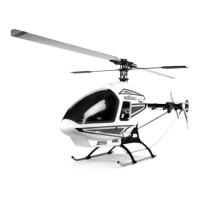34
UNDERSTANDING SWASHPLATE CONTROL SYSTEMS
Currently, there are several different types of control systems available on the market. Although the mechanical methods for
transferring control to the swashplate vary, the different control systems can be broken down into two categories: 1 Servo
(conventional) and CCPM (Cyclic/ Collective Pitch Mixing).
The following is an explanation of the two most popular types of swashplate control.
1. 1 Servo Standard Swashplate Control
The 1 Servo Standard System is found in a wide variety of radio
controlled helicopters. The term “1 Servo” means that the control
system requires one servo to operate each separate swashplate
function. With this system, a total of three servos is required to operate
the three main swashplate functions, which are Aileron (roll), Elevator
(pitch) and Collective functions. With this type of control system, each
servo works independently and is assigned to a specific function. In
other words, the Aileron (roll) servo is assigned to move only the
Aileron (roll) function, as is the Elevator (pitch) servo, etc. Since these
servos operate completely independently of each other, the servo torque
to each control surface is limited to the maximum torque rating of the
servos used.
The 1 Servo Standard system swashplate is designed so that the
lower swashplate ring control balls are spaced at 90° to each other. This
system is also most commonly arranged so that the Aileron (roll) axis of
the swashplate is positioned at 90° to the main mechanics of the
helicopter, and the Elevator (pitch) axis is parallel to the mechanics.
Please refer to the diagram at right for clarification.
With this type of system, it is necessary for the helicopter to be
designed using an intermediate mechanical mixing system so that the
control inputs can be transferred from the three independent servos to the swashplate in such a manner that the three controls can be
achieved. This mechanical mixing system allows the swashplate to both Roll (Aileron) and Pitch (Elevator), as well as slide up and down
the main rotor shaft for Collective pitch inputs. These mechanical mixing systems generally require the use of many ball bearings and
control rods to achieve this result.
Elevator control ball is in line
with helicopter frame
Aileron Axis
Elevator Axis
Aileron control ball is 90°
to elevator control ball
and helicopter frame
Standard “1 Servo” Swashplate System
90°

